child restraint HONDA ACCORD COUPE 2017 9.G Quick Guide
[x] Cancel search | Manufacturer: HONDA, Model Year: 2017, Model line: ACCORD COUPE, Model: HONDA ACCORD COUPE 2017 9.GPages: 84, PDF Size: 7.3 MB
Page 5 of 84

2 || 3
S
AFETYVISUAL INDEX
Dashboard and Other Controls
1 Audio system/touchscreen*/
navigation* system p. 53, p. 78,
p. 86
2 Hazard warning button
3 Climate control system p. 46
4 Seat heater switches* p. 46
5 USB port p. 49 Wireless charger* p. 50
Accessory power socket p. 49
6 rearview mirror p. 44
7 Power window switches p. 33
Door lock switches p. 32
Door mirror controls p. 45
8 Fuel fill door release handle
p. 116
Trunk release button
p. 32
9 Shift lever p. 100
10 Hood release handle p. 134
11 Driving Position Memory System
buttons* p. 43
*if equipped
SAFETY INFORMATION
2
4
71
8
6
3
Your safety—and the safety of others—is very important, and operati\
ng this vehicle
safely is an important responsibility. While we strive to help you make informed
decisions about safety, it is not practical or possible to warn you about all the
hazards associated with operating or maintaining your vehicle. Therefore\
, you must
use your own good judgment.
Important Safety Information
This guide explains many of your vehicle’s safety features and how to use them.
Please read this information carefully. Following the instructions below will also help
to keep you and your passengers safe.
Important Safety Precautions
•
Always wear your seat belt.
•
Secure all children in the proper restraint system.
•
Be aware of airbag hazards.
•
Don’t drink and drive.
•
Pay appropriate attention to the task of driving safely.
•
Control your speed.
•
Keep your vehicle in safe condition.
engaging in cell phone conversation or other activities that keep you fro\
m paying
close attention to the road, other vehicles, and pedestrians could lead \
to a crash.
remember
, situations can change quickly, and only you can decide when it is safe
to divert some attention away from driving.
Safety Messages
When you see the following messages throughout this guide, pay close att\
ention.
You WILL be KILLeD or SerIoUSL
Y HU
rT if you don’
t follow
instructions.
You CAN be KILLeD or SerIoUSL
Y HU
rT if you don’
t follow
instructions.
You CAN be HUrT if you don’
t follow instructions.
This information is intended to help you avoid damage to your
vehicle, other property, or the environment.
DANGER
WARNING
CAUTION
NOTICE
5910
11
Page 8 of 84
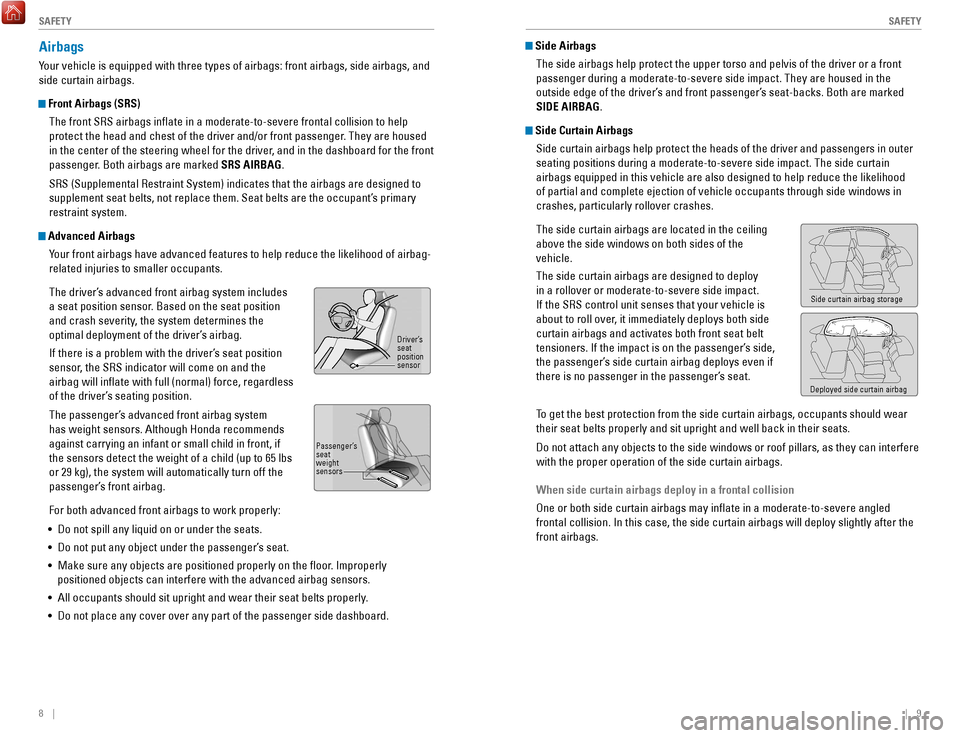
8 || 9
S
AFETYSAFETY
Airbags
Your vehicle is equipped with three types of airbags: front airbags, side\
airbags, and
side curtain airbags.
Front Airbags (SRS)
The front S
rS airbags inflate in a moderate-to-severe frontal collision to help
protect the head and chest of the driver and/or front passenger
. They are housed
in the center of the steering wheel for the driver, and in the dashboard for the front
passenger. Both airbags are marked SRS AIRBAG.
S
rS (Supplemental restraint System) indicates that the airbags are designed to
supplement seat belts, not replace them. Seat belts are the occupant’\
s primary
restraint system.
Advanced Airbags
Your front airbags have advanced features to help reduce the likelihood o\
f airbag-
related injuries to smaller occupants.
The driver’s advanced front airbag system includes
a seat position sensor. Based on the seat position
and crash severity, the system determines the
optimal deployment of the driver’s airbag.
If there is a problem with the driver’s seat position
sensor, the S
rS indicator will come on and the
airbag will inflate with full (normal) force, regardless
of the driver’
s seating position.
The passenger’s advanced front airbag system
has weight sensors. Although Honda recommends
against carrying an infant or small child in front, if
the sensors detect the weight of a child (up to 65 lbs
or 29 kg), the system will automatically turn off the
passenger’s front airbag.
For both advanced front airbags to work properly:
•
Do not spill any liquid on or under the seats.
•
Do not put any object under the passenger’s seat.
•
Make sure any objects are positioned properly on the floor. Improperly
positioned objects can interfere with the advanced airbag sensors.
•
All occupants should sit upright and wear their seat belts properly.
•
Do not place any cover over any part of the passenger side dashboard.
Side Airbags The side airbags help protect the upper torso and pelvis of the driver o\
r a front
passenger during a moderate-to-severe side impact. They are housed in th\
e
outside edge of the driver’s and front passenger’s seat-backs. Both are marked
SIDE AIRBAG.
Side Curtain AirbagsSide curtain airbags help protect the heads of the driver and passengers\
in outer
seating positions during a moderate-to-severe side impact. The side curt\
ain
airbags equipped in this vehicle are also designed to help reduce the li\
kelihood
of partial and complete ejection of vehicle occupants through side windo\
ws in
crashes, particularly rollover crashes.
The side curtain airbags are located in the ceiling
above the side windows on both sides of the
vehicle.
The side curtain airbags are designed to deploy
in a rollover or moderate-to-severe side impact.
If the S
rS control unit senses that your vehicle is
about to roll over
, it immediately deploys both side
curtain airbags and activates both front seat belt
tensioners. If the impact is on the passenger’s side,
the passenger’s side curtain airbag deploys even if
there is no passenger in the passenger’s seat.
To get the best protection from the side curtain airbags, occupants shoul\
d wear
their seat belts properly and sit upright and well back in their seats.
Do not attach any objects to the side windows or roof pillars, as they c\
an interfere
with the proper operation of the side curtain airbags.
When side curtain airbags deploy in a frontal collision
one or both side curtain airbags may inflate in a moderate-to-severe an\
gled
frontal collision. In this case, the side curtain airbags will deploy sl\
ightly af
ter the
front airbags.
Driver’s
seat
position
sensor
Passenger’s
seat
weight
sensors
Side curtain airbag storage
Deployed side curtain airbag
Page 9 of 84
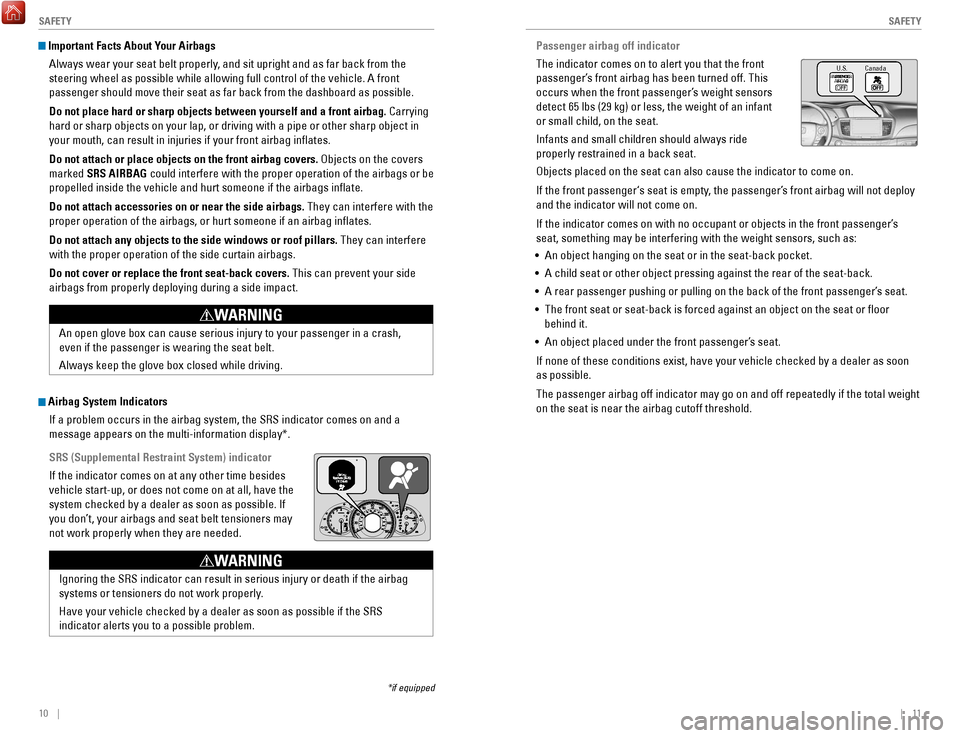
10 || 11
S
AFETYSAFETY
Important Facts About Your Airbags
Always wear your seat belt properly, and sit upright and as far back from the
steering wheel as possible while allowing full control of the vehicle. A\
front
passenger should move their seat as far back from the dashboard as possi\
ble.
Do not place hard or sharp objects between yourself and a front airbag. Carrying
hard or sharp objects on your lap, or driving with a pipe or other sharp\
object in
your mouth, can result in injuries if your front airbag inflates.
Do not attach or place objects on the front airbag covers.
objects on the covers
marked
SRS AIRBAG could interfere with the proper operation of the airbags or be
propelled inside the vehicle and hurt someone if the airbags inflate.
Do not attach accessories on or near the side airbags. They can interfere with the
proper operation of the airbags, or hurt someone if an airbag inflates\
.
Do not attach any objects to the side windows or roof pillars. They can interfere
with the proper operation of the side curtain airbags.
Do not cover or replace the front seat-back covers. This can prevent your side
airbags from properly deploying during a side impact.
Airbag System Indicators
If a problem occurs in the airbag system, the S
rS indicator comes on and a
message appears on the multi-information display*.
SRS (Supplemental Restraint System) indicator
If the indicator comes on at any other time besides
vehicle start-up, or does not come on at all, have the
system checked by a dealer as soon as possible. If
you don’
t, your airbags and seat belt tensioners may
not work properly when they are needed. Passenger airbag off indicator
The indicator comes on to alert you that the front
passenger’s front airbag has been turned off. This
occurs when the front passenger’s weight sensors
detect 65 lbs (29 kg) or less, the weight of an infant
or small child, on the seat.
Infants and small children should always ride
properly restrained in a back seat.
objects placed on the seat can also cause the indicator to come on.
If the front passenger‘s seat is empty
, the passenger’s front airbag will not deploy
and the indicator will not come on.
If the indicator comes on with no occupant or objects in the front passe\
nger’s
seat, something may be interfering with the weight sensors, such as:
•
An object hanging on the seat or in the seat-back pocket.
•
A child seat or other object pressing against the rear of the seat-back.\
•
A rear passenger pushing or pulling on the back of the front passenger’\
s seat.
•
The front seat or seat-back is forced against an object on the seat or fl\
oor
behind it.
•
An object placed under the front passenger’s seat.
If none of these conditions exist, have your vehicle checked by a dealer\
as soon
as possible.
The passenger airbag off indicator may go on and off repeatedly if the t\
otal weight
on the seat is near the airbag cutoff threshold.
An open glove box can cause serious injury to your passenger in a crash,\
even if the passenger is wearing the seat belt.
Always keep the glove box closed while driving.
WARNING
*
Ignoring the SrS indicator can result in serious injury or death if the airbag
systems or tensioners do not work properly.
Have your vehicle checked by a dealer as soon as possible if the S
rS
indicator alerts you to a possible problem.
WARNING
U.S. Canad a
*if equipped
Page 10 of 84
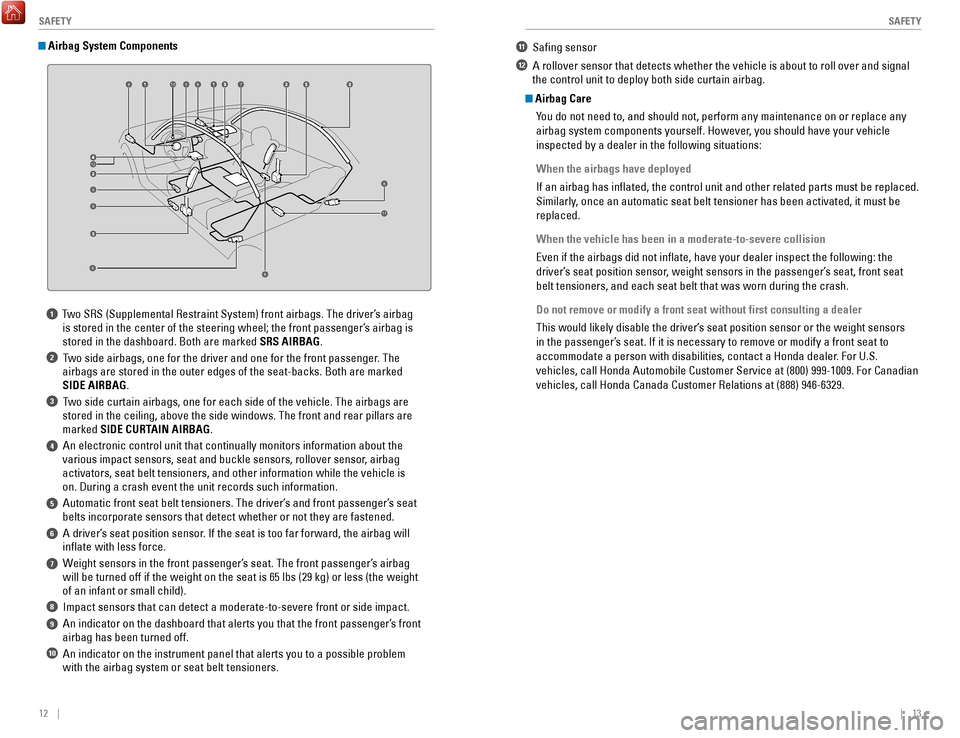
12 || 13
S
AFETYSAFETY
1 Two SrS (Supplemental restraint System) front airbags. The driver’s airbag
is stored in the center of the steering wheel; the front passenger’s airbag is
stored in the dashboard. Both are marked
SRS AIRBAG.
2 Two side airbags, one for the driver and one for the front passenger. The airbags are stored in the outer edges of the seat-backs. Both are marked\
SIDE AIRBAG.
3 Two side curtain airbags, one for each side of the vehicle. The airbags a\
re stored in the ceiling, above the side windows. The front and rear pillar\
s are
marked SIDE CURTAIN AIRBAG.
4 An electronic control unit that continually monitors information about\
the various impact sensors, seat and buckle sensors, rollover sensor, airbag
activators, seat belt tensioners, and other information while the vehicl\
e is
on. During a crash event the unit records such information.
5 Automatic front seat belt tensioners. The driver’s and front passenger’s seat belts incorporate sensors that detect whether or not they are fastened.
6 A driver’s seat position sensor. If the seat is too far forward, the airbag will inflate with less force.
7 Weight sensors in the front passenger’s seat. The front passenger’s airbag will be turned off if the weight on the seat is 65 lbs (29 kg) or less\
(the weight
of an infant or small child).
8 Impact sensors that can detect a moderate-to-severe front or side impa\
ct.
9 An indicator on the dashboard that alerts you that the front passenger\
’s front airbag has been turned off.
10 An indicator on the instrument panel that alerts you to a possible pro\
blem with the airbag system or seat belt tensioners.
Airbag System Components
Airbag Care
You do not need to, and should not, perform any maintenance on or replace\
any
airbag system components yourself. However, you should have your vehicle
inspected by a dealer in the following situations:
When the airbags have deployed
If an airbag has inflated, the control unit and other related parts mu\
st be replaced.
Similarly, once an automatic seat belt tensioner has been activated, it must be
replaced.
When the vehicle has been in a moderate-to-severe collision
even if the airbags did not inflate, have your dealer inspect the follo\
wing: the
driver’
s seat position sensor, weight sensors in the passenger’s seat, front seat
belt tensioners, and each seat belt that was worn during the crash.
Do not remove or modify a front seat without first consulting a dealer
This would likely disable the driver’s seat position sensor or the weight sensors
in the passenger’s seat. If it is necessary to remove or modify a front seat to
accommodate a person with disabilities, contact a Honda dealer. For U.S.
vehicles, call Honda Automobile Customer Service at (800) 999-1009. Fo\
r Canadian
vehicles, call Honda Canada Customer
relations at (888) 946-6329.
6
7
8
9
8
8
8
8810
11
12
11 Safing sensor
12 A rollover sensor that detects whether the vehicle is about to roll ov\
er and signal the control unit to deploy both side curtain airbag.
Page 12 of 84

16 || 17
S
AFETYSAFETY
Protecting Smaller Children
If a child is at least one year old and within the weight range indicate\
d by the child
seat manufacturer, the child should be properly restrained in a firmly secured
forward-facing child seat.
We strongly recommend placing a forward-facing
child seat in a rear seating position.
Placing a forward-facing child seat in the front seat
can be hazardous, even with advanced front airbags
that automatically turn the passenger’s front airbag
off. A rear seat is the safest place for a child.
Selecting a Child SeatMost child seats are LATCH-compatible (Lower Anchors and Tethers for CHildren).
Some have a rigid-type connector, while others have a flexible-type connector.
Both are equally easy to use. Some existing and previously owned child s\
eats can
only be installed using the seat belt. Whichever type you choose, follow\
the child
seat manufacturer’s use and care instructions as well as the instructions in this
manual. Proper installation is key to maximizing your child’s safety.
In seating positions and vehicles not equipped with LATCH, a LATCH-compatible
child seat can be installed using the seat belt and a top tether for add\
ed security.
This is because all child seats are required to be designed so that they\
can be
secured with a lap belt or the lap part of a lap/shoulder belt. In addit\
ion, the
child seat manufacturer may advise that a seat belt be used to attach a \
LATCH-
compatible seat once a child reaches a specified weight. Please read t\
he child
seat owner’s manual for proper installation instructions.
Important considerations when selecting a child seat
Make sure the child seat meets the following three requirements:
•
The child seat is the correct type and size for the child.
•
The child seat is the correct type for the seating position.
•
The child seat is compliant with Federal Motor vehicle Safety Standard 213 or
Canadian Motor
vehicle Safety Standard 213.
Installing a LATCH-Compatible Child Seat
A LATCH-compatible child seat can be installed in either of the two outer re\
ar
seats. A child seat is attached to the lower anchors with either the rig\
id or flexible
type of connectors.
1.
Locate the lower anchors under the marks.
2.
Place the child seat on the vehicle seat, then
attach the child seat to the lower anchors
according to the instructions that came with the
child seat. Make sure that the lower anchors
are not obstructed by the seat belt or any other
object.
3.
open the tether anchor cover behind the head
restraint.
4.
raise the head restraint to its highest position,
then route the tether strap between the head
restraint legs, and secure the tether strap hook
onto the anchor
.
5.
Tighten the tether strap according to the seat
maker’
s instructions.
6.
Make sure the child seat is firmly secured by
rocking it forward and back and side to side; little
movement should be felt.
7.
Make sure any unused seat belt that a child
can reach is buckled, the lockable retractor
is activated, and the belt is fully retracted and
locked.
Placing a forward-facing child seat in the front seat can result in seri\
ous
injury or death if the front airbag inflates.
If you must place a forward-facing child seat in front, move the vehicle\
seat
as far back as possible, and properly restrain the child.
WARNING
Anchor
Tether
strap
hoo k
Marks
Rigid type
Lower anchors
Flexible type
Page 13 of 84
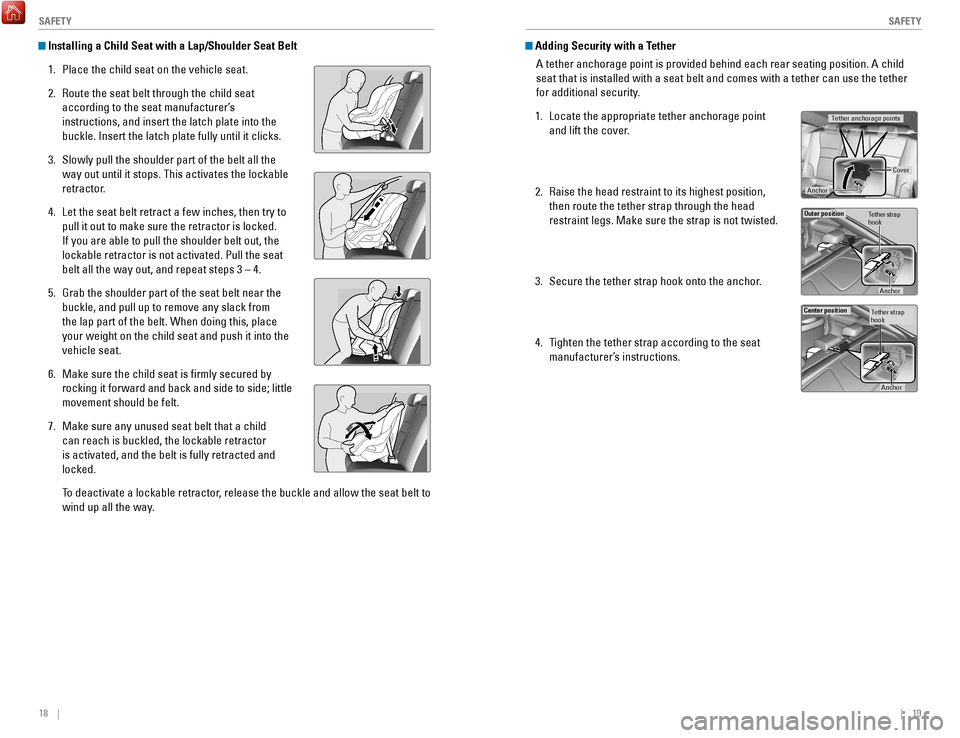
18 || 19
S
AFETYSAFETY
Installing a Child Seat with a Lap/Shoulder Seat Belt
1.
Place the child seat on the vehicle seat.
2.
route the seat belt through the child seat
according to the seat manufacturer’
s
instructions, and insert the latch plate into the
buckle. Insert the latch plate fully until it clicks.
3.
Slowly pull the shoulder part of the belt all the
way out until it stops. This activates the lockable
retractor.
4.
Let the seat belt retract a few inches, then try to
pull it out to make sure the retractor is locked.
If you are able to pull the shoulder belt out, the
lockable retractor is not activated. Pull the seat
belt all the way out, and repeat steps 3 – 4.
5.
Grab the shoulder part of the seat belt near the
buckle, and pull up to remove any slack from
the lap part of the belt. When doing this, place
your weight on the child seat and push it into the
vehicle seat.
6.
Make sure the child seat is firmly secured by
rocking it forward and back and side to side; little
movement should be felt.
7.
Make sure any unused seat belt that a child
can reach is buckled, the lockable retractor
is activated, and the belt is fully retracted and
locked.
To deactivate a lockable retractor
, release the buckle and allow the seat belt to
wind up all the way. Adding Security with a Tether
A tether anchorage point is provided behind each rear seating position. \
A child
seat that is installed with a seat belt and comes with a tether can use \
the tether
for additional security.
1.
Locate the appropriate tether anchorage point
and lift the cover.
2.
raise the head restraint to its highest position,
then route the tether strap through the head
restraint legs. Make sure the strap is not twisted.
3.
Secure the tether strap hook onto the anchor.
4.
Tighten the tether strap according to the seat
manufacturer’
s instructions.
Tether anchorage points
Cover
Anchor
Outer positi on
Tether strap
hook
Anchor
Center positionTether strap
hook
Anchor
Page 83 of 84
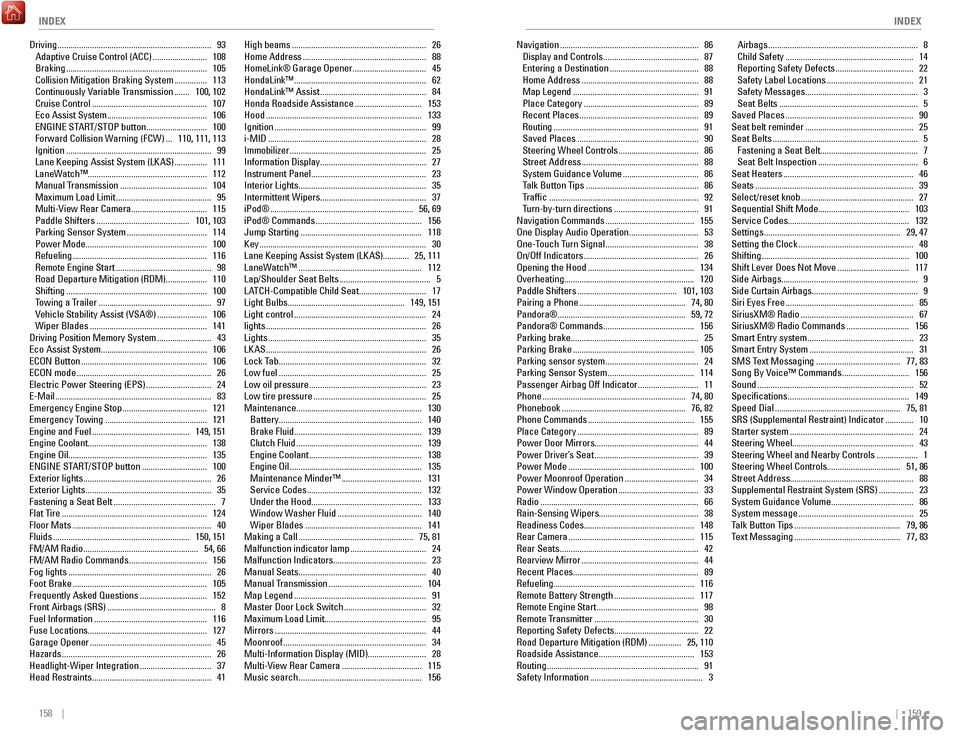
158 || 159
INDEX
INDEX
Driving ....................................................................... 93
Adaptive Cruise Control (ACC) ......................... 108
Braking ................................................................. 105
Collision Mitigation Braking System ............... 113
Continuously variable Transmission ....... 100
, 102
Cruise Control
..................................................... 107eco Assist System .............................................. 106eNGINe ST
A
rT/SToP button ............................ 100
Forward Collision W
arning (FCW)
... 110
, 111, 113
Ignition
................................................................... 99
Lane Keeping Assist System (LKAS) ............... 111
LaneW
atch™....................................................... 112
Manual Transmission
........................................ 104
Maximum Load Limit ............................................ 95
Multi-view rear Camera ................................... 115
Paddle Shifters ........................................... 101
, 103
Parking Sensor System
..................................... 114
Power Mode ........................................................ 100refueling .............................................................. 116remote engine Start ............................................ 98road Departure Mitigation (rDM)
................... 110
Shifting
................................................................. 100
T
owing a Trailer
.................................................... 97vehicle Stability Assist (vSA®) ....................... 106
Wiper Blades ...................................................... 141
Driving Position Memory System ......................... 43eco Assist System
................................................. 106
eCoN Button .......................................................... 106eCoN mode .............................................................. 26electric Power Steering (ePS) .............................. 24e-Mail ........................................................................\
83emergency engine Stop ....................................... 121emergency T
owing
............................................... 121engine and Fuel ............................................. 149
, 151
engine Coolant
....................................................... 138
engine oil
................................................................ 135
eNGINe ST
A
rT/SToP button .............................. 100exterior lights ........................................................... 26exterior Lights .......................................................... 35
Fastening a Seat Belt ............................................... 7
Flat T
ire
................................................................... 124
Floor Mats ................................................................ 40
Fluids ............................................................... 150
, 151
FM/AM
radio ..................................................... 54
, 66
FM/AM
radio Commands .................................... 156
Fog lights .................................................................. 26
Foot Brake .............................................................. 105
Frequently Asked Questions ............................... 152
Front Airbags (SrS) .................................................. 8
Fuel Information .................................................... 116
Fuse Locations
....................................................... 127
Garage
opener ........................................................ 45
Hazards ..................................................................... 26
Headlight-Wiper Integration ................................. 37
Head restraints ....................................................... 41High beams
..............................................................
26
Home Address ......................................................... 88
HomeLink® Garage opener .................................. 45
HondaLink™ ............................................................. 62
HondaLink™ Assist ................................................. 84
Honda roadside Assistance ............................... 153
Hood ........................................................................\
133
Ignition ...................................................................... 99
i-MID ........................................................................\
. 28
Immobilizer ............................................................... 25
Information Display
................................................. 27
Instrument Panel
..................................................... 23
Interior Lights
........................................................... 35
Intermittent Wipers................................................. 37
iPod®
.................................................................. 56
, 69
iPod® Commands
................................................. 156
Jump Starting ........................................................ 118
Key ........................................................................\
..... 30
Lane Keeping Assist System (LKAS)
............ 25, 111
LaneWatch™
......................................................... 112
Lap/Shoulder Seat Belts .......................................... 5
LATCH-Compatible Child Seat ............................... 17
Light Bulbs
...................................................... 149, 151
Light control
............................................................. 24
lights ........................................................................\
.. 26
Lights ........................................................................\
. 35
LKAS ........................................................................\
.. 26
Lock T
ab
.................................................................... 32
Low fuel .................................................................... 25
Low oil pressure ...................................................... 23
Low tire pressure .................................................... 25
Maintenance
.......................................................... 130
Battery
.................................................................. 140
Brake Fluid ........................................................... 139
Clutch Fluid .......................................................... 139engine Coolant .................................................... 138engine oil ............................................................. 135
Maintenance Minder™ ..................................... 131
Service Codes ..................................................... 132
Under the Hood ................................................... 133
Window Washer Fluid ....................................... 140
Wiper Blades ...................................................... 141
Making a Call ..................................................... 75
, 81
Malfunction indicator lamp
................................... 24
Malfunction Indicators
........................................... 23
Manual Seats........................................................... 40 Manual Transmission
........................................... 104
Map Legend ............................................................. 91
Master Door Lock Switch ...................................... 32
Maximum Load Limit............................................... 95
Mirrors
...................................................................... 44
Moonroof .................................................................. 34
Multi-Information Display (MID)
........................... 28
Multi-
view rear Camera ..................................... 115
Music search ......................................................... 156Navigation
................................................................
86
Display and Controls ............................................ 87entering a Destination ......................................... 88
Home Address ...................................................... 88
Map Legend .......................................................... 91
Place Category ..................................................... 89recent Places ....................................................... 89routing ................................................................... 91
Saved Places ........................................................ 90
Steering Wheel Controls ..................................... 86
Street Address ...................................................... 88
System Guidance volume ................................... 86
T
alk Button Tips
.................................................... 86
T
raffic
..................................................................... 92
T
urn-by-turn directions
....................................... 91
Navigation Commands ......................................... 155one Display Audio operation ................................ 53one-T
ouch Turn Signal ........................................... 38on/off Indicators ..................................................... 26opening the Hood ................................................. 134overheating
............................................................ 120
Paddle Shifters
.............................................. 101
, 103
Pairing a Phone
................................................. 74
, 80
Pandora®
........................................................... 59
, 72
Pandora® Commands
.......................................... 156
Parking brake........................................................... 25 Parking Brake
........................................................ 105
Parking sensor system ........................................... 24
Parking Sensor System ........................................ 114
Passenger Airbag off Indicator ............................ 11
Phone .................................................................. 74
, 80
Phonebook
......................................................... 76
, 82
Phone Commands
................................................. 155
Place Category ........................................................ 89
Power Door Mirrors
................................................ 44
Power Driver’s Seat
................................................ 39
Power Mode .......................................................... 100
Power Moonroof operation .................................. 34
Power Window operation ..................................... 33radio ........................................................................\
. 66rain-Sensing Wipers
.............................................. 38
readiness Codes
................................................... 148
rear Camera .......................................................... 115rear Seats ................................................................ 42rearview Mirror ...................................................... 44recent Places
.......................................................... 89
refueling
................................................................. 116
remote Battery Strength ..................................... 117remote engine Start ............................................... 98remote T
ransmitter
................................................ 30reporting Safety Defects
....................................... 22
road Departure Mitigation (rDM) ............... 25
, 110
roadside Assistance ............................................ 153routing ...................................................................... 91
Safety Information .................................................... 3Airbags
.....................................................................
8
Child Safety ........................................................... 14reporting Safety Defects .................................... 22
Safety Label Locations ........................................ 21
Safety Messages .................................................... 3
Seat Belts ................................................................ 5
Saved Places ........................................................... 90
Seat belt reminder .................................................. 25
Seat Belts ................................................................... 5
Fastening a Seat Belt ............................................. 7
Seat Belt Inspection .............................................. 6
Seat Heaters ............................................................ 46
Seats ........................................................................\
. 39
Select/reset knob .................................................... 27
Sequential Shift Mode
.......................................... 103
Service Codes........................................................ 132 Settings ............................................................... 29 , 47
Setting the Clock ..................................................... 48
Shifting .................................................................... 100
Shift Lever Does Not Move ................................. 117
Side Airbags............................................................... 9 Side Curtain Airbags................................................. 9
Siri
eyes Free ........................................................... 85
SiriusXM® radio .................................................... 67
SiriusXM® radio Commands ............................. 156
Smart entry system ................................................. 23
Smart entry System ................................................ 31
SMS T
ext Messaging
....................................... 77,
83
Song By
voice™ Commands ............................... 156
Sound ........................................................................\
52
Specifications ........................................................ 149
Speed Dial .......................................................... 75
, 81
S
rS (Supplemental restraint) Indicator ............. 10
Starter system ......................................................... 24
Steering Wheel
........................................................ 43
Steering Wheel and Nearby Controls
................... 1
Steering Wheel Controls
.................................. 51, 86
Street Address......................................................... 88 Supplemental
restraint System (SrS) ................ 23
System Guidance volume ...................................... 86
System message ..................................................... 25
T
alk Button Tips
................................................. 79
, 86
Text Messaging
................................................. 77
, 83